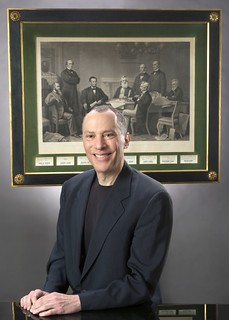
PREV ARTICLE
NEXT ARTICLE
FULL ISSUE
PREV FULL ISSUE
INTERVIEW: JAMES HALPERIN OF HERITAGEIn a December 20, 2016 article, Andrea Valluzzo of Antiques and the Arts Weekly interviews Jim Halperin of Heritage. -Editor
Tell us about your start in the coins/antiques trade. I was interested in business from a very early age because I wanted to be like my dad, who was and still is my hero and role model. From age 7 or 8 on, I would routinely start little businesses and get all our neighborhood kids involved. I was actually a comic book dealer and comics fanzine publisher when I was 10 or 11 years old, long before I became a coin dealer. I got interested in stamps as a kid because my grandfather was a pretty serious collector, but had never collected coins for more than a few months or had ever known how to value them. I knew all about Scott’s catalog and Linn’s Stamp News, but I’d never even seen a coin price guide or newspaper. When I was 16 I opened a stamp store as a summer project, and as an afterthought I called it Jim’s Stamp and Coin Shop, figuring it didn’t hurt to have another product line. Kids would come in ask me if I had any coins and I would have to tell them that I didn’t really know much about coins. So several of them offered to teach me and somehow I convinced them to work for me for free until I could afford to pay them. Turns out I had a knack for coins and it wasn’t long before I actually did start paying them. A few years later I dropped out of Harvard after just three semesters to pursue numismatics full time. How did a pair of college dropouts who were business rivals come together to form what is now the third largest US-auction house with annual sales in excess of $860,000? Our merger occurred in 1982 when the coin market was the worst we had ever seen. Steve and I owned the two largest rare coin companies in America, but both companies were suddenly losing money hand over fist. Steve wrote out a plan on a pad of yellow-lined paper, and convinced me that we could combine forces and do as much business with only 75 percent of the overhead. The math was compelling. At the time my company was deeply in debt and insolvent and I was desperate to pay the creditors as quickly as possible to protect my reputation. Bankruptcy was not an option for me, because I knew if my dad was in the same situation he would have found a way to pay every dime he owed. So when Steve offered me half of his business at book value for a nonrecourse note if I would move to Dallas, I accepted. I threw in the parts of my business that Steve thought were a good fit, basically my wholesale business, European operations and a fledgling auction company I’d started in 1975. Then I sold any assets Steve didn’t want to one of my Boston employees, and focused on our new company, renamed Heritage. Everything Steve predicted on that yellow pad came true almost immediately. I had my creditors paid off in full within a few months, and I think it took me less than a year to fully pay off the nonrecourse note to Steve. Everyone in the coin business thought our partnership would last a few years, but 34 years later we’re still in business together. Second best decision I ever made. Anyone who knows the girl I married in 1984 can tell you what my best decision was. How is Heritage’s approach unique to the auction business different than your corporate competitors? We were the first auction house to disclose every reserve at least three days before each option, so bidders don’t have to guess which lots are worth their time and attention. Christie’s, Sotheby’s and the other art auction houses still haven’t followed suit, which amazes me, but most collectibles auction companies have copied that. We were also the first auction house to maintain a permanent, public online archive of every item we sold so bidders and other could research values for free. Basically our philosophy is to save our clients as much time as possible, to be as transparent as possible, and never to intentionally mislead anyone. To read the complete article, see:  Wayne Homren, Editor The Numismatic Bibliomania Society is a non-profit organization promoting numismatic literature. See our web site at coinbooks.org. To submit items for publication in The E-Sylum, write to the Editor at this address: whomren@gmail.com To subscribe go to: https://my.binhost.com/lists/listinfo/esylum All Rights Reserved. NBS Home Page Contact the NBS webmaster 
|
